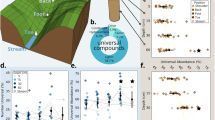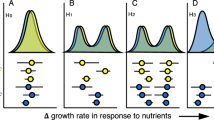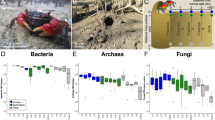Abstract
Biota can be described in terms of elemental composition, expressed as an atomic ratio of carbon:nitrogen:phosphorus (refs 1–3). The elemental stoichiometry of microoorganisms is fundamental for understanding the production dynamics and biogeochemical cycles of ecosystems because microbial biomass is the trophic base of detrital food webs4,5,6. Here we show that heterotrophic microbial communities of diverse composition from terrestrial soils and freshwater sediments share a common functional stoichiometry in relation to organic nutrient acquisition. The activities of four enzymes that catalyse the hydrolysis of assimilable products from the principal environmental sources of C, N and P show similar scaling relationships over several orders of magnitude, with a mean ratio for C:N:P activities near 1:1:1 in all habitats. We suggest that these ecoenzymatic ratios reflect the equilibria between the elemental composition of microbial biomass and detrital organic matter and the efficiencies of microbial nutrient assimilation and growth. Because ecoenzymatic activities intersect the stoichiometric and metabolic theories of ecology7,8,9, they provide a functional measure of the threshold at which control of community metabolism shifts from nutrient to energy flow.
This is a preview of subscription content, access via your institution
Access options
Subscribe to this journal
Receive 51 print issues and online access
$199.00 per year
only $3.90 per issue
Buy this article
- Purchase on Springer Link
- Instant access to full article PDF
Prices may be subject to local taxes which are calculated during checkout


Similar content being viewed by others
References
Redfield, A. The biological control of chemical factors in the environment. Am. Sci. 46, 205–221 (1958)
Reich, P. B. & Oleksyn, J. Global patterns of plant leaf N and P in relation to temperature and latitude. Proc. Natl Acad. Sci. USA 101, 11001–11006 (2004)
Cleveland, C. C. & Liptzin, D. C:N:P stoichiometry in soil: is there a “Redfield ratio” for the microbial biomass? Biogeochemistry 85, 235–252 (2006)
Elser, J. J. et al. Nutritional constraints in terrestrial and freshwater foodwebs. Nature 408, 578–580 (2000)
Sterner, R. W. & Elser, J. J. Ecological Stoichiometry: The Biology of Elements from Molecules to the Biosphere (Princeton Univ. Press, 2002)
Manzoni, S., Jackson, R. B., Trofymow, J. A. & Porporato, A. The global stoichiometry of litter nitrogen mineralization. Science 321, 684–686 (2008)
Gillooly, J. F. et al. The metabolic basis of whole-organism RNA and phosphorus content. Proc. Natl Acad. Sci. USA 102, 11923–11927 (2005)
Kerkoff, A. J., Enquist, B. J., Elser, J. J. & Fagan, W. F. Plant allometry, stoichiometry and temperature-dependence of primary productivity. Glob. Ecol. Biogeogr. 14, 585–598 (2005)
Allen, A. P. & Gillooly, J. F. Towards an integration of ecological stoichiometry and the metabolic theory of ecology to better understand nutrient cycling. Ecol. Lett. 12, 369–384 (2009)
Brown, J. H., Gillooly, J. F., Allen, A. P., Savage, V. M. & West, G. B. Toward a metabolic theory of ecology. Ecology 85, 1771–1789 (2004)
Houghton, R. A. Balancing the global carbon budget. Annu. Rev. Earth Planet. Sci. 35, 313–347 (2007)
Cole, J. et al. Plumbing the global carbon cycle: integrating inland waters into the terrestrial carbon budget. Ecosystems 10, 171–184 (2007)
Chróst, R. J. Microbial Enzymes in Aquatic Environments (Springer, 1991)
Burns, R. G. & Dick, R. P. Enzymes in the Environment: Activity, Ecology and Applications (Dekker, 2002)
Allison, S. D., Gartner, T., Holland, K., Weintraub, M. & Sinsabaugh, R. L. in Manual of Environmental Microbiology (eds Hurst, C. J., Knudsen, G. R., McInerney, M. J., Stetzenbach, L. D. & Walter, M. V.) 704–711 (ASM Press, 2007)
Schimel, J. P. & Weintraub, M. N. The implications of exoenzyme activity on microbial carbon and nitrogen limitation in soil: a theoretical model. Soil Biol. Biochem. 35, 549–563 (2003)
Moorhead, D. L. & Sinsabaugh, R. L. A theoretical model of litter decay and microbial interaction. Ecol. Monogr. 76, 151–174 (2006)
Cross, W. F., Benstead, J. P., Frost, P. C. & Thomas, S. A. Ecological stoichiometry in freshwater benthic systems: recent progress and perspectives. Freshwat. Biol. 50, 1895–1912 (2005)
Sinsabaugh, R. L. et al. Stoichiometry of soil enzyme activity at global scale. Ecol. Lett. 11, 1252–1264 (2008)
Sinsabaugh, R. L. & Follstad Shah, J. J. Integrating resource utilization and temperature in metabolic scaling of riverine bacterial production. Ecol. Monogr. (in the press)
Olander, L. P. & Vitousek, P. M. Regulation of soil phosphatase and chitinase activity by N and P availability. Biogeochemistry 49, 175–190 (2000)
Sinsabaugh, R. L., Carreiro, M. M. & Repert, D. A. Allocation of extracellular enzymatic activity in relation to litter composition, N deposition, and mass loss. Biogeochemistry 60, 1–24 (2002)
Sinsabaugh, R. L., Gallo, M. E., Lauber, C., Waldrop, M. & Zak, D. R. Extracellular enzyme activities and soil carbon dynamics for northern hardwood forests receiving simulated nitrogen deposition. Biogeochemistry 75, 201–215 (2005)
Frost, P. C. et al. Threshold elemental ratios of carbon and phosphorus in aquatic consumers. Ecol. Lett. 9, 774–779 (2006)
Herron, P. M., Stark, J. M., Holt, C., Hooker, T. & Cardon, Z. G. Microbial growth efficiencies across a soil moisture gradient assessed using 13C-acetic acid vapor and 15N-ammonia gas. Soil Biol. Biochem. 41, 1262–1269 (2009)
Sand-Jensen, K., Pedersen, N. L. & Sondergaard, M. Bacterial metabolism in small temperate streams under contemporary and future climates. Freshwat. Biol. 52, 2340–2353 (2007)
Parton, W. et al. Global-scale similarities in nitrogen release patterns during long term decomposition. Science 315, 361–362 (2007)
Hill, B. H. et al. Sediment microbial enzyme activity as an indicator of nutrient limitation in Great Lakes coastal wetlands. Freshwat. Biol. 51, 1670–1683 (2006)
Hill, B. H., Elonen, C. M., Jicha, T. M., Bolgrien, D. W. & Moffett, M. F. Sediment microbial enzyme activity as an indicator of nutrient limitation in the great rivers of the Upper Mississippi River basin. Biogeochemistry 10.1007/s10533-009-9366-0 (2009)
Warton, D. I., Wright, J., Falster, D. S. & Westoby, M. Bivariate line-fitting methods for allometry. Biol. Rev. Camb. Phil. Soc. 81, 259–291 (2006)
Acknowledgements
J.J.F.S. was supported by the National Science Foundation (DBI-0630558).
Author Contributions R.L.S. provided data from soils. B.H.H. provided data from freshwater sediments. J.J.F.S. and R.L.S. collaborated on data synthesis and interpretation. All authors contributed to manuscript preparation.
Author information
Authors and Affiliations
Corresponding author
Supplementary information
Supplementary Information
This file contains a Supplementary Discussion, Supplementary Methods, Supplementary Data, Supplementary Tables S1-S2, Supplementary Figures S1 and Supplementary References. (PDF 1463 kb)
PowerPoint slides
Rights and permissions
About this article
Cite this article
Sinsabaugh, R., Hill, B. & Follstad Shah, J. Ecoenzymatic stoichiometry of microbial organic nutrient acquisition in soil and sediment. Nature 462, 795–798 (2009). https://doi.org/10.1038/nature08632
Received:
Accepted:
Issue Date:
DOI: https://doi.org/10.1038/nature08632
This article is cited by
-
Global emergent responses of stream microbial metabolism to glacier shrinkage
Nature Geoscience (2024)
-
Relative increases in CH4 and CO2 emissions from wetlands under global warming dependent on soil carbon substrates
Nature Geoscience (2024)
-
Edaphic factors control microbial biomass and elemental stoichiometry in alpine meadow soils of the Tibet Plateau
Plant and Soil (2024)
-
How to adequately represent biological processes in modeling multifunctionality of arable soils
Biology and Fertility of Soils (2024)
-
Salt–Alkali-Resistant Phosphate-Solubilizing Bacterium: Kushneria sp. YCWA18 Improves Soil Available Phosphorus and Promotes the Growth of Suaeda salsa
Journal of Plant Growth Regulation (2024)
Comments
By submitting a comment you agree to abide by our Terms and Community Guidelines. If you find something abusive or that does not comply with our terms or guidelines please flag it as inappropriate.



